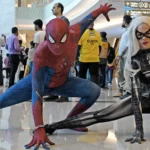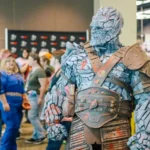
Introduction – Most Successful Female Comic
The realm of comics, a dynamic and colourful world teeming with creativity and imagination, has been significantly enriched by the contributions of numerous talented female artists and writers. Among these luminaries, one name shines particularly bright – Rumiko Takahashi. With her works selling well over 100 million copies, she has etched her name in the annals of comic history as perhaps the most successful female comic book creator of all time.
The importance of female representation in the comic industry is a topic of paramount significance. It brings to the table a plethora of diverse perspectives and narratives, challenging long-standing stereotypes and broadening the scope of storytelling. Female comics have not merely carved a niche for themselves in the industry; they have also left an indelible mark on popular culture, shaping perceptions and breaking barriers.
Successful female comics have had a profound impact on the industry and popular culture. Their work resonates with a wide audience, transcending boundaries of age, gender, and geography. They have paved the way for future generations of female artists, inspiring them to dream big and break new ground in the comic industry. Their impact is profound and far-reaching, forever altering the landscape of comics and popular culture.
Early Pioneers and Trailblazers
In the nascent stages of the comic industry, a select group of audacious women dared to challenge societal norms and etch their names in a domain predominantly occupied by men. These early pioneers and trailblazers faced a myriad of challenges, but their indomitable spirit and exceptional talent laid the foundation for future generations of female comic creators.
One of the earliest pioneers in this arena was Jackie Ormes, who holds the distinction of being the first African-American woman cartoonist. Born as Zelda Mavin Jackson in 1911, Ormes embarked on her illustrious career in 1937.
She is celebrated for creating the comic strip “Torchy Brown” and the panel “Patty-Jo ‘n’ Ginger”. Her work presented a humorous yet realistic portrayal of African-American women, a stark contrast to the stereotypical images of blacks prevalent in the mainstream press of the time.
Another luminary in the industry is Ramona Fradon, one of the first female artists to lend her talent to DC Comics. Born in 1926, Fradon kickstarted her career in 1950. She is renowned for her work on “Aquaman” and “Brenda Starr” and for co-creating the superhero “Metamorpho”.
These women, along with others like them, encountered significant challenges in their careers. The comic industry, much like many others, was predominantly male. Women often grappled with a lack of support, lower income, perceived incompetence, mistreatment, and an overall lack of voice.
They also had to contend with workplace harassment and discrimination. Despite these formidable obstacles, they persevered, crafting memorable characters and narratives that continue to resonate with readers to this day.
Their success has not only opened doors for other women in the industry but also enriched the world of comics with diverse narratives and perspectives. Their legacy continues to inspire aspiring female artists to challenge the status quo and make their mark in the comic industry.
The journey was fraught with challenges, but their determination and talent have ensured that their impact will be felt for generations to come. Their stories of resilience and creativity serve as a beacon of inspiration for all those who dare to dream and create.
Their contributions to the comic industry are a testament to their talent and tenacity, and their legacy continues to inspire and influence the world of comics.
Rising Stars and Iconic Characters

The Ascendancy of Female Comics
In recent decades, the comic book industry has witnessed a significant surge in the success of female comics. This shift is not merely a trend but a reflection of the changing societal norms and the increasing demand for diverse narratives. Women writers have emerged as a formidable force in the comic world, bringing fresh perspectives and challenging the traditional norms of storytelling.
One such notable figure is Gail Simone, a critically acclaimed writer who has made substantial contributions to DC Comics, including Batgirl, Birds of Prey, and Red Sonja. Her work on these titles has not only been well-received but has also paved the way for other female writers in the industry.
Iconic Characters and Their Creators
The impact of female comic creators extends beyond their success. They have been instrumental in creating and shaping some of the most iconic characters in the comic universe. Wonder Woman, created by William Moulton Marston, was later written by Gail Simone, marking her as the longest-running female writer on Wonder Woman.
Another groundbreaking character is Ms. Marvel, brought to life by G. Willow Wilson. These characters have not only gained popularity but have also played a crucial role in challenging and reshaping gender stereotypes.
Empowering Women and Challenging Stereotypes
The influence of these iconic characters transcends the pages of comic books. Wonder Woman, with her strength and compassion, embodies a blend of femininity that is both powerful and nurturing. Her character challenges the conventional dichotomy of strength and femininity, proving that these traits can coexist and even complement each other.
Despite facing criticism, Wonder Woman stands as a feminist icon, breaking barriers as a woman-led superhero movie. Diana’s strength stems from a place of distinctly female power and experience, making the film a significant breakthrough in the industry.
Similarly, Ms Marvel represents a new generation of superheroes, relatable ones and reflects the diversity of the real world. Her character has resonated with a broad audience, further emphasizing the need for diverse representation in comics.
Commercial Success and Critical Acclaim
The Commercial Success of Female Comics
The comic book industry has seen a significant rise in the commercial success of female comics. This success is not just measured in terms of sales figures, but also in the recognition and awards these comics have received.
One such example is Lynda Barry, a prominent figure in the comic world, known for her weekly comic strip “Ernie Pook’s Comeek” and her illustrated novel “The Good Times Are Killing Me”. Her unique storytelling style and relatable characters have resonated with a wide audience, leading to substantial commercial success. Her graphic novel “What It Is” was recognized with an Eisner Award in 2009 for Best Reality-Based Work, further cementing her status in the industry.
Recognition and Awards
Recognition and awards are a testament to the quality and impact of these comics. Alison Bechdel, creator of the long-running comic strip “Dykes to Watch Out For”, has received critical acclaim for her graphic memoir titled “Fun Home”.
This memoir was not only a commercial success but also adapted into a Tony Award-winning musical, demonstrating the cultural impact of her work. Furthermore, her graphic novel was named one of the 10 Best Books of the Year by Time magazine, a prestigious recognition that underscores the importance and relevance of her work.
Reception from Critics and Fans
The reception of these comics from both critics and fans has been overwhelmingly positive. The narratives crafted by these women have been celebrated from the late 19th century to the present day. Their work has not only achieved commercial success but also left a significant impact on popular culture, challenging stereotypes and empowering women.
Cultural Significance
The cultural significance of these comics extends beyond their commercial success. They have challenged traditional norms and stereotypes, providing a platform for diverse narratives and representation. Their stories have resonated with audiences, emphasizing the importance of diversity in comics.
Conclusion
In this blog post, we have explored the rise of successful female comics and their significant impact on the comic industry. We have highlighted the achievements of notable figures such as Gail Simone and Alison Bechdel, who have not only achieved commercial success but also created iconic characters that have resonated with a wide audience.
We have also discussed the critical acclaim received by these comics, including prestigious awards and recognition. These accolades are a testament to the quality and relevance of their work, and the positive reception from both critics and fans underscores their cultural significance.
The importance of recognizing and celebrating the achievements of female comics cannot be overstated. Their work has challenged traditional norms and stereotypes, providing a platform for diverse narratives and representation. They have shown that female characters can be powerful and lead their own stories, thereby inspiring countless readers around the world.
Looking ahead, we are optimistic about the future of female representation in the comic industry. The continued success of female comic creators is a promising sign of further progress. As we continue to celebrate their achievements, we look forward to seeing more diverse and empowering narratives in the world of comics. Their stories will continue to inspire, challenge, and reshape the comic industry for years to come.







